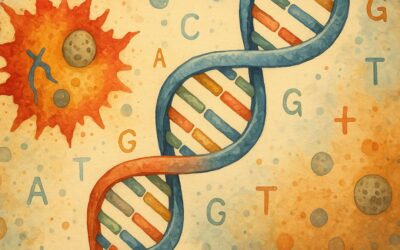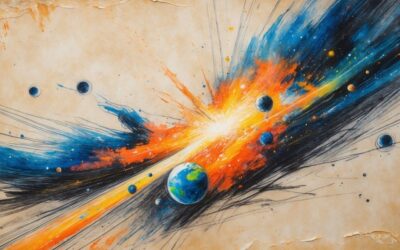Have you ever looked up at the night sky and wondered about the fundamental building blocks of our reality? What if the very essence of the universe, the particles we take for granted, aren’t tiny dots at all? String theory offers a radical answer – the universe may be composed of unimaginably small, vibrating strings of energy.
Tiny Strings, Big Ideas
At the heart of this paradigm-shifting idea lies the quest to unify two giants of physics that seem inherently at odds: quantum mechanics and general relativity. Quantum mechanics reigns supreme in the realm of the tiny, describing atoms, electrons, and light with mindboggling accuracy. General relativity, on the other hand, paints the universe on a cosmic canvas, explaining gravity and the motion of planets and galaxies. String theory posits that we could possibly bridge this chasm with strings.
Imagine these strings as being so small that even the most powerful microscopes would fail to see them. Like the strings of a violin or guitar, they can vibrate in a variety of patterns. Surprisingly, string theory suggests that each distinct vibration mode may actually correspond to a different fundamental particle we observe in the universe. One vibration could be an electron, another a quark, and even the gravity-carrying particle, the graviton, is theorized to arise from a vibrating string.
The Dance of Dimensions
The elegance of string theory doesn’t stop there. While it beautifully incorporates these subatomic players, it also hints at something remarkable: the existence of hidden dimensions beyond the three spatial dimensions (length, width, height) and time that we experience. To make the mathematics of string theory work, additional dimensions are needed, curled up or folded in on themselves. These curled dimensions might be incredibly small, possibly smaller than even a single atom. Yet they could contain vibrating strings that create the forces and particles we see in our world.
Real-World Connections
The implications of string theory are profound. Imagine a single theory that could potentially explain the strong force that binds atomic nuclei, the weak force responsible for radioactive decay, electromagnetism, and, finally, the elusive gravity. It’s a “theory of everything”, a way to tie up the loose ends of our understanding. It sounds a bit like the physics version of a beautiful orchestral symphony.
Beyond the abstract realm of theorizing, string theory could help us solve the mystery of black holes. Our current understanding of physics breaks down at the heart of these bizarre cosmic objects. String theory, however, hints at possible solutions that could unravel their deepest secrets. It would open new avenues to understand some of the most exotic phenomena in the universe.
Challenges and Possibilities
String theory is not without its challenges. As of yet, there’s no direct experimental evidence to prove its existence. The energies needed to see strings, if they are indeed real, are so incredibly high that our current technology cannot reach them. However, scientists remain endlessly fascinated by its potential. The mathematical framework of string theory is consistently beautiful, leaving experts to wonder if this symphony of vibrations is the underlying tune played by the universe.
Your Path to Discovery
Now that you’ve had a glimpse into this captivating theory, embrace the spirit of curiosity! Dig deeper into the resources available on string theory and its connection to other areas of physics. Consider what this radical way of thinking could mean for areas like cosmology and quantum computing. Remember, physics seeks to make sense of the world around us, and it never hurts to imagine the universe in unexpected ways!
Why Should You Care?
- The Grand Unification: String theory offers the tantalizing possibility of uniting our understanding of all the forces of nature into a single, elegant framework. If successful, it would revolutionize our perception of reality and provide an awe-inspiring “theory of everything”.
- Answers to Big Questions: String theory could lead to a deeper understanding of black holes, gravity’s place in the quantum world, and potentially even the processes that occurred during the Big Bang!
- Fostering Imagination: Even if string theory remains unproven, the ideas it introduces stretch our imagination and force us to consider realities far different from our everyday experience. This sparks creative thinking and a sense of wonder about the world.
Key Takeaways
- Beyond Particles: String theory suggests that the fundamental building blocks of the universe might not be point-like particles, but tiny vibrating strings of energy.
- Hidden Dimensions: For string theory’s mathematics to work, it proposes the existence of additional dimensions beyond the four we experience directly.
- Universal Harmony: Different vibrational patterns of strings could correspond to different particles and forces, providing a single foundation for our understanding of the cosmos.
Keywords
- String theory: A theoretical framework attempting to unify general relativity and quantum mechanics by positing tiny strings as the fundamental building blocks of matter and energy.
- Vibrations: Oscillations or patterns of movement within the strings that, according to the theory, give rise to different particles and forces.
- Quantum mechanics: The highly successful physics theory governing the behavior of matter and energy at the atomic and subatomic level.
- General relativity: Einstein’s theory describing gravity as the curvature of spacetime.
- Dimensions: Directions of measurement; we know of three spatial dimensions (length, width, height), and spacetime adds time as the fourth. String theory proposes additional curled-up dimensions.
- Particle: A tiny point-like unit of matter or a quantum of energy.
- Force: A push or pull causing an interaction between objects. The fundamental forces include gravity, electromagnetism, the strong force, and the weak force.
- Black hole: A region in spacetime where gravity is so powerful that nothing can escape, not even light.
- Big Bang: The prevailing cosmological model describing the universe’s hot and dense early state and its subsequent expansion.
- Cosmology: The scientific study of the origin, structure, and evolution of the universe.
Frequently Asked Questions (FAQs)
- Can string theory be experimentally proven? Sadly, the energies necessary to observe strings directly are far beyond our current technological capabilities. Thus, scientists focus on indirect tests and on analyzing predictions that string theory makes for observable phenomena.
- How big are the hidden dimensions proposed by string theory? These extra dimensions are believed to be curled within an unimaginably small space, even smaller than individual atoms.
- Are there different versions of string theory? Yes! Over the years, several variants of string theory have been developed, including Superstring theory and M-theory.
Myth Buster
- Myth: String theory is pure science fiction with no connection to reality.
- Reality: String theory, while speculative, is grounded in complex mathematics and is a serious field of physics research. Though experimental proof remains elusive, its ability to potentially unify major forces is enticing for many scientists.
Let’s Talk!
- If strings exist, what could they be made of? Pure energy? Something else?
- Do you think the presence of hidden dimensions is more plausible or absurd?
- How could string theory change our understanding of time and space?
Don’t hesitate to share your thoughts in the comments!










0 Comments